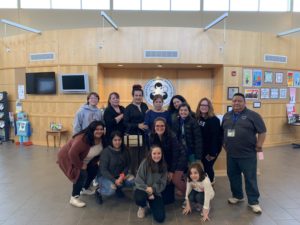Dual Spanish-English program voted into SFSD
March 29, 2019
A child shouts across the playground, “Come on!” Another responds, “Esperame!” The Sioux Falls School Districts (SFSD) aims to make this a reality.
Next fall, parents in the Rosa Parks and Hayward districts will have the option to send their kindergarteners to a dual-language program, where half of the students will be native-Spanish speakers learning English and the other half will be native-English speakers learning Spanish. The twist? The students will be in the same class. The program was approved by the SFSD board Monday with Carly Reiter being the only member voting against the proposed pilot program.
The chamber was filled with proponents and opponents alike, prepared to testify. In fact, three members of the Garcia family testified in favor of the program.
“I am a mother, I work outside the house and I am a very busy woman,” said Rosa Linda García. “I would love to teach [my daughters] more about [Spanish], but I don’t have the wisdom that the [dual-language] program would have.”
Nan Baker agreed that the program would help develop the skill of Spanish speakers, but also English speakers too.
“From an EL point of view, Spanish speakers learn English better and deeper if they learn how to read and write in their native language,” said Baker. “On the flip side, we have a growing population of non-native speakers who are interested in learning Spanish. To think that the two groups can coexist and help each other in mutual interest is very exciting. We [would be] using our local resources here to help.”
The opponents agreed, but they were worried about the timeline.
“We’re not opposed to the dual language program,” said Tiffany Wehmeyer, a kindergarten teacher at Hayward Elementary. “We’re just asking for a delay. We want to make sure the program is the best it can be.”
Wehmeyer’s fellow kindergarten teacher Jeanne Hoff expanded on the concerns brought up in Wehmyer’s testimony.
“The concern is the preparedness of the intertwining of the English and Spanish program,” said Hoff. “They don’t know how it’s going to fit together, at least they haven’t told us. You can spot when a teacher is not ready to go, and that’s what we fear. Those kids deserve a teacher who is ready to go from day one. We were never against the program, it was how fast it was coming at us.”
While their concerns were heard in the meeting, some felt the mentioned obstacles were negligible compared to the benefits of the program.
“I understand that there are concerns about the planning [of the program],” said Dr. Pilar Cabrera. “But the Spanish Immersion program has developed and is doing wonderful, and I’m sure not everything was solved when it was about to launch. We can see that there is a lot of community and support.”
At the end of the day, the strengths of the program won over the board.
“My son was in the dual program in Texas,” said LHS Spanish teacher Monica Conover. “And I know how important it is. The U.S. is the next country [where Spanish is spoken the most]. We need more people to be able to speak Spanish.”
Not only does the program promise to teach biliteracy, but it also aims to unite diverse communities.
“We’re also seeing an increase in the population of Spanish speakers here in Sioux Falls,” said Baker. “And the dual program allows for more access. To get down to it, to think that we could have our Latino parents involved in the classroom- what they bring to the table- is incredibly engaging and enriching.”
Furthermore, proponents argued that the dual program provides education the Immersion Center simply can’t.
“Even though the Spanish Immersion program here in Sioux Falls is fantastic, I am aware of the limitations,” said Dr. Cabrera. “My 10-year-old always makes the same mistakes, and there is no way that I can convince him that it is ‘la silla,’ and not ‘el silla.’ Why is that, if I tell [him] all the time, and his teachers tell him all the time? [It’s] because he does not have peers that do not make the same mistake.”
Administration also recommended the passage of the program, citing a Texas study that found student’s test scores, in English and Spanish, were massively improved by similar programs. Furthermore, proponents argued that the program would allow for students to grow academically while also staying true to their familial histories.
“It is important not to lose our roots,” said Otto García, the Latino ambassador for the city of Sioux Falls. “I came to the U.S. at the age of 19, served in the armed forces and I believe that many of the kids that are coming to the U.S. are losing their identity. My daughter, she was born in the U.S., if you ask her anything about my country, she won’t know anything. So that’s why I see the importance of the Spanish classes. I believe America is made of different cultures, that’s what makes this country great.”






